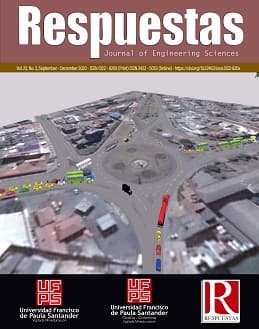Análisis computacional del calentamiento híbrido de una configuración heterogénea de núcleo-caparazón para mejorar la uniformidad de la temperatura
Computational analysis of hybrid heating of a heterogeneous core-shell configuration for improving temperature uniformity
Contenido principal del artículo
A lo largo de este estudio se propone utilizar el calentamiento híbrido (microondas - radiación térmica) sobre una estructura heterogénea. El objetivo es mejorar la eficacia de su tratamiento térmico. Se analiza un conjunto core-shell con diferentes propiedades térmicas y eléctricas. Una esfera sólida constituye el núcleo del conjunto. Dicho núcleo está rodeado por tres capas de diferentes materiales. Debido a las propiedades del sistema original, se propone modificar el núcleo para que absorba las microondas. Las capas son todas homogéneas y transparentes a las microondas. Las dos primeras presentan una baja conductividad térmica, mientras que la más externa es un buen conductor térmico. También se propone añadir una fina capa de susceptor entre las dos primeras capas, tratando de paliar el problema de la baja conducción térmica. Además, la constante de pérdida dieléctrica de esta nueva capa depende de la temperatura. Se supone que la esfera compuesta cuelga dentro de la cavidad electromagnética y gira continuamente, por lo que recibe homogéneamente microondas y radiación térmica (de una resistencia eléctrica). Así, el modelo térmico viene dado por un conjunto de ecuaciones diferenciales parciales dependientes del tiempo. Se analizan los perfiles de temperatura transitorios bajo diferentes escenarios experimentales. La utilización del calentamiento híbrido propuesto presenta una clara ventaja en este caso concreto.
Descargas
Datos de publicación
Perfil evaluadores/as N/D
Declaraciones de autoría
Indexado en
- Sociedad académica
- Universidad Francisco de Paula Santander
- Editorial
- Universidad Francisco de Paula Santander
Detalles del artículo
J. Sun, W. Wang, and Q. Yue, “Review on Microwave-Matter Interaction Fundamentals and Efficient Microwave-Associated Heating Strategies,” Materials (Basel)., vol. 9, no. 4, 2016.
Z. Song et al., “Microwave drying performance of single-particle coal slime and energy consumption analyses,” FUEL Process. Technol., vol. 143, pp. 69–78, Mar. 2016.
W. Wang et al., “Quantitative measurement of energy utilization efficiency and study of influence factors in typical microwave heating process,” ENERGY, vol. 87, pp. 678–685, Jul. 2015.
R. Roy, R. Peelamedu, L. Hurtt, J. P. Cheng, and D. Agrawal, “Definitive experimental evidence for Microwave Effects: radically new effects of separated E and H fields, such as decrystallization of oxides in seconds,” Mater. Res. Innov., vol. 6, no. 3, pp. 128–140, Sep. 2002.
K. Kashimura, H. Sugawara, M. Hayashi, T. Mitani, and N. Shinohara, “Microwave heating behavior and microwave absorption properties of barium titanate at high temperatures,” AIP Adv., vol. 6, no. 6, Jun. 2016.
H. Sugawara et al., “Temperature dependence and shape effect in high-temperature microwave heating of nickel oxide powders,” Phys. B-CONDENSED MATTER, vol. 458, pp. 35–39, Feb. 2015.
H. Zhu, T. Gulati, A. K. Datta, and K. Huang, “Microwave drying of spheres: Coupled electromagnetics-multiphase transport modeling with experimentation. Part I: Model development and experimental methodology,” FOOD Bioprod. Process., vol. 96, pp. 314–325, Oct. 2015.
A. J. Buttress et al., “Design and optimisation of a microwave reactor for kilo-scale polymer synthesis,” Chem. Eng. Sci. X, vol. 2, 2019.
M. Kumar, D. M. Phase, and R. J. Choudhary, “Structural, ferroelectric and dielectric properties of multiferroic YMnO3 synthesized via microwave assisted radiant hybrid sintering,” HELIYON, vol. 5, no. 5, May 2019.
R. I. Badiger, S. Narendranath, and M. S. Srinath, “Optimization of Process Parameters by Taguchi Grey Relational Analysis in Joining Inconel-625 Through Microwave Hybrid Heating,” Metallogr. Microstruct. Anal., vol. 8, no. 1, pp. 92–108, Feb. 2019.
N. M. Maliessa and S. R. A. Idris, “Effect of Different Amount of Silicon Carbide on SAC Solder-Cu Joint Performance by Using Microwave Hybrid Heating Method,” in IOP Conference Series: Materials Science and Engineering, 2019, vol. 469, no. 1.
N. Chhanwal, P. R. Bhushette, and C. Anandharamakrishnan, “Current Perspectives on Non-conventional Heating Ovens for Baking Process—a Review,” Food Bioprocess Technol., vol. 12, no. 1, 2019.
S. L. Marahadige, S. M. Sridharmurthy, A. H. Jayraj, U. S. Mahabaleshwar, G. Lorenzini, and E. Lorenzini, “Development of copper alloy by microwave hybrid heating technique and its characterization,” Int. J. HEAT Technol., vol. 36, no. 4, pp. 1343–1349, 2018.
A. C. Meredith R. J.; Metaxas, Industrial microwave heating. Peter Peregrinus, 1993.








